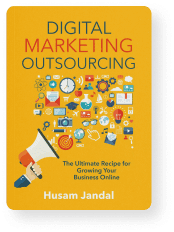 You’re doing everything right—posting content, running ads, optimizing your website—so why aren’t you getting results? The truth is, being online isn’t enough. In today’s overcrowded digital landscape, if your brand doesn’t stand out, it gets ignored. In this guide, you’ll learn why differentiating your brand from your digital marketing competition is essential and get proven strategies to help you do it.
You’re doing everything right—posting content, running ads, optimizing your website—so why aren’t you getting results? The truth is, being online isn’t enough. In today’s overcrowded digital landscape, if your brand doesn’t stand out, it gets ignored. In this guide, you’ll learn why differentiating your brand from your digital marketing competition is essential and get proven strategies to help you do it.
The Harsh Reality of Digital Marketing Competition and Why It’s So Hard to Stand Out
Digital markets are more competitive than ever, and that’s largely due to two key factors: the power of consumer choice and how algorithms dictate visibility.
Consumer Choice Plays a Crucial Role in a Saturated Market
Unlike in traditional markets, where geographic limitations often narrow consumer options, digital platforms put thousands, sometimes millions, of competitors just a click away. This abundance of choice fundamentally changes how businesses operate online.
- Lower Barriers to Entry: It’s easier than ever to launch a business. Platforms like Shopify, Amazon, and social media allow companies to reach global audiences with minimal upfront investment.
- Endless Options for Consumers: Whether someone is looking for a factoring company, a BPO service provider, or a fitness app, they have dozens, if not hundreds, of choices at their fingertips.
- Shift in Power to Consumers: Because switching between businesses is effortless online, customer expectations are higher. They expect speed, personalization, and value, or they’ll move on to a competitor.
This intense competition means that standing out requires more than just having a great product or service. You need brand differentiation, a strong digital presence, and strategic marketing.
Algorithms Shape Visibility and Competition
Even if you have the best offering in the market, you’ll struggle if your business doesn’t rank well in search results, social feeds, or eCommerce marketplaces. That’s because digital visibility is largely controlled by algorithms.
Search Engines (Google, Bing, etc.)
Google processes over 8.5 billion searches per day, Internet Live Stats reports. About 90 percent of people never click past page one, according to Forbes. If your business isn’t ranking well, it’s practically invisible. Google’s algorithm favors:
- Experience, Expertise, Authority, and Trustworthiness (E-E-A-T): Critical for industries like finance, healthcare, and legal services.
- Mobile-friendliness and Page Speed: Slow-loading sites get penalized.
- Content Quality and Relevance: Long-form, informative content tends to rank better than thin, keyword-stuffed pages.
Social Media Algorithms (LinkedIn, Facebook, Instagram, TikTok, etc.)
Organic reach has plummeted in recent years. On Facebook, organic reach typically hovers between just one and two percent, per Social Status. Platforms prioritize:
- Engagement Signals: Shares, comments, and time spent on content boost reach.
- Personalization: AI-driven feeds show content tailored to individual users, meaning businesses must create content that resonates with niche audiences.
- Video and Interactive Content: TikTok, Instagram Reels, and YouTube Shorts dominate because they keep users on-platform longer.
Marketplace and Advertising Algorithms (Amazon, Google Ads, Facebook Ads, etc.)
Paid advertising is now an expectation, not an option. Platforms favor:
- Bid Strategies and Relevance Scores: The highest bid doesn’t always win—ad relevance and expected engagement matter.
- Customer Behavior Data: AI-driven ads predict what users want before they search for it.
- Retargeting and Personalization: Businesses that leverage first-party data and audience segmentation perform better.
You Must Develop a Strategy for Beating the Competition
As you can see, in today’s overcrowded digital landscape, you’re not just competing against other businesses in your industry. You’re competing against algorithms that decide what your audience sees. A strategic approach is required if you want your brand to stand out. Let’s take a look at how it’s done.
Step 1: Define Your Unique Value Proposition (UVP)
Your UVP is the core reason why customers should choose your business instead of a competitor. It’s not just what you offer, but why it matters to your audience.
A strong UVP is:
- Clear and Specific: Avoid generic claims like “best customer service” or “high quality.” Instead, highlight exactly what makes you different.
- Customer-Focused: Your UVP should address customer pain points and goals, not just your features.
- Easily Understood: If your UVP takes too long to explain, you’ve already lost your audience.
Identify What Sets Your Brand Apart
To carve out your unique space in a crowded market, ask yourself some probing questions about your brand, purpose, and strengths.
What Can You Offer That Competitors Can’t?
- Faster Service: Do you deliver results in hours instead of days?
- More Personalization: Do you provide a tailored experience?
- Better Accessibility: Do you make your product or service easier to access?
- Tech-Driven Innovation: Do you leverage cutting-edge technology?
Where Do Your Competitors Fall Short?
- Analyze Customer Reviews: Read not just your own reviews but your competitors’ as well. If customers consistently complain about poor response times, hidden fees, or lack of transparency, that’s your opportunity.
- Solve Common Frustrations: If an industry standard is slow turnaround times, inefficient customer service, or outdated technology, emphasize how your business does it differently.
What Are Your Customers’ Most Pressing Pain Points?
- Understand the Core Problem: What is the biggest frustration your customers face?
- Address Switching Barriers: What stops them from leaving a subpar solution for something better?
- Focus on What Matters Most: What is the real value they’re seeking beyond the product itself?
Communicate Your UVP Through Clear Messaging
Once you know what makes you different, you need to communicate it effectively across all channels.
Keep It Front and Center
- Prioritize Visibility: Your UVP should be the first thing people see on your website, social media bios, and ad campaigns.
- Avoid Generic Welcomes: If your homepage just says, “Welcome to [Company Name],” you’re missing an opportunity to make a strong first impression.
Speak to Emotions, Not Just Features
- Appeal to Aspirations and Frustrations: Logic matters, but buying decisions are often emotional. Instead of just listing features, connect with your audience’s deeper needs.
- Shift from Features to Benefits: Don’t just describe what your product does. Explain how it improves the customer’s life.
Test and Refine Based on Customer Response
- Run A/B Tests: Experiment with different website headlines, ad copy, and email subject lines to see what resonates most.
- Adapt Over Time: Your UVP should evolve as market conditions and customer expectations change.
Step 2: Leverage Data to Drive Competitive Strategies
Guesswork isn’t enough if you want to stand out in a crowded digital space. Savvy businesses use data-driven insights to make smarter marketing, sales, and customer experience decisions.
By leveraging analytics and competitive intelligence, you can:
- Spot Gaps: Identify market gaps before your competitors do.
- Improve: Refine your marketing efforts to maximize impact.
- Pivot: Adapt faster to industry shifts and customer needs.
Use Analytics to Identify Gaps in the Market
One of the biggest advantages of digital marketing is access to real-time data. But simply collecting data isn’t enough. You need to know how to analyze it and act on it.
Key Areas to Analyze for Market Gaps
- Search Trends: Use tools like Google Trends, Semrush, or Ahrefs to find rising search topics and underserved queries in your industry.
- Customer Behavior: Analyze website heatmaps using tools like Hotjar and Microsoft Clarity, as well as session recordings, to see where users drop off and identify potential improvements.
- Content Performance: Use Google Analytics or your content management system to track which blog topics and landing pages perform best. If a topic underperforms but has a high search volume, it may need a fresh take.
- Social Listening: Tools like Brandwatch and Sprout Social can help you track real-time discussions and customer sentiment about your brand and competitors.
How to Take Action on Market Gaps
- Pivot Content Strategy: If you identify high-interest topics with little competition, create targeted blog posts, videos, or downloadable guides.
- Develop New Offers: If customer behavior suggests frustration with industry norms, create a solution your competitors lack.
- Refine Ad Targeting: Data insights can reveal which audiences engage most, helping you optimize ad spend.
Track Competitor Performance for Strategic Insights
Your competitors are also fighting for attention. Tracking their performance helps you learn what’s working and what isn’t.
Key Metrics to Monitor
- SEO and Keyword Rankings: Tools like Ahrefs and Moz can show you which keywords your competitors rank for and where you have opportunities to outrank them.
- Ad Performance: Facebook Ad Library and Google Ads Transparency Center allow you to see competitors’ active campaigns and analyze ad copy, formats, and engagement.
- Social Media Engagement: Compare your engagement rates to competitors using tools like Sprout Social or Rival IQ. Low engagement signals weak messaging.
- Website and Conversion Benchmarks: Use tools like SimilarWeb or BuiltWith to analyze site traffic sources, bounce rates, and conversion rates of competitors.
How to Apply Competitor Insights
- Differentiate Your Messaging: If competitors all say the same thing, take a contrarian stance to stand out.
- Outperform in Underserved Areas: If competitors lack thought leadership on certain topics, dominate those spaces.
- Refine Positioning and Offers: Track what competitors discount or phase out. This often signals industry shifts.
Step 3: Enhance Your Digital Presence Across Channels
A strong digital presence is a requirement for businesses that want to stay competitive. However, simply being online is not enough. You need a strategic, multi-channel approach to ensure your brand is visible, engaging, and driving conversions.
By optimizing your digital presence across platforms, you can:
- Increase Visibility: Position your brand where your audience already spends time.
- Improve Engagement: Deliver relevant, high-quality content that encourages interaction.
- Drive Conversions: Make it easy for potential customers to take action.
Optimize Content for Maximum Reach and Engagement
Creating content is one thing. Ensuring it reaches and engages the right audience is another. To maximize effectiveness, content must be optimized for reach, engagement, and conversions.
Key Strategies to Improve Content Performance
- Use Platform-Specific Content Formats: Adapt content to fit the preferred formats of each platform to maximize engagement.
- Prioritize High-Engagement Content Types: Use formats like video, interactive elements, and visual storytelling to capture attention.
- Optimize for Search (SEO and Social Algorithms): Ensure content is discoverable by structuring it with relevant keywords, hashtags, and metadata.
- Leverage Data-Driven Content Adjustments: Use analytics tools like Google Analytics or BuzzSumo to identify which topics, formats, and headlines generate the most engagement.
How to Take Action
- Audit Content Performance: Identify high- and low-performing content, then refine underperforming formats.
- Test Content Lengths and Styles: Experiment with different formats to determine what resonates best with your audience.
- Align Content Distribution with Platform Behavior: Ensure that each piece of content is optimized for how audiences consume information on that platform.
Build a Cohesive Multi-Channel Marketing Strategy
Relying on a single marketing channel, such as SEO, email, or social media, limits your reach. A well-executed multi-channel strategy ensures you engage with your audience at multiple touchpoints.
Key Elements of a Multi-Channel Strategy
- Maintain Consistent Brand Messaging: Ensure your brand voice and message remain uniform across all platforms.
- Cross-Promote Between Channels: Use one platform to drive traffic to another and create an interconnected experience.
- Diversify Traffic Sources: Avoid relying too heavily on a single platform for customer acquisition.
- Ensure Seamless User Experience (UX): Optimize for consistency across devices and platforms so customers have a smooth transition between touchpoints.
How to Take Action
- Map Out Your Audience’s Journey: Identify how your target audience interacts with different platforms and tailor messaging accordingly.
- Create a Unified Content Plan: Develop content that aligns across multiple channels while maintaining platform-specific optimization.
- Use Automation Tools to Streamline Campaigns: Leverage tools like HubSpot or Marketo to manage content distribution and track performance across channels.
Step 4: Foster Strong Customer Relationships to Build Loyalty
Attracting new customers is important, but long-term success comes from retaining them. A strong brand does more than just generate sales. It builds lasting relationships that keep customers coming back.
By focusing on customer loyalty, you can:
- Increase Customer Lifetime Value (CLV): Loyal customers spend more and return more frequently.
- Reduce Customer Acquisition Costs (CAC): Retaining an existing customer is far less expensive than acquiring a new one.
- Strengthen Brand Advocacy: Satisfied customers are more likely to recommend your business and generate referrals.
Leverage Personalization to Boost Customer Retention
Today’s consumers expect tailored experiences based on their interests, behaviors, and past interactions. Generic messaging is no longer effective. Personalization is key to building loyalty.
Key Personalization Strategies
- Segment Customers Based on Behavior: Use CRM data to categorize customers by purchase history, engagement level, or preferences.
- Deliver Personalized Content and Offers: Tailor promotions, email campaigns, and website experiences to individual users.
- Use Dynamic Email Marketing: Automated emails that adjust based on user activity are more engaging than static email blasts.
- Implement Personalized Customer Support: Use AI-driven chatbots and human support to provide customized assistance.
How to Take Action
- Equip Yourself: Invest in CRM and automation tools to track customer preferences and personalize interactions.
- Research: Analyze customer behavior data to refine personalization strategies.
- Iterate: Test and optimize personalized experiences to improve engagement and retention.
Use Social Proof and Testimonials to Build Trust
Trust is one of the most powerful factors in customer decision-making. People are more likely to buy from brands that others recommend. By showcasing real experiences, you reinforce credibility and strengthen customer relationships.
Key Social Proof Strategies
- Feature Customer Testimonials: Positive experiences from real customers make your brand more relatable and trustworthy.
- Showcase Reviews and Ratings: High ratings and detailed reviews improve credibility and influence purchasing decisions.
- Leverage Influencer and Industry Endorsements: Partnering with credible figures in your industry can enhance trust.
- Use Real Data and Success Stories: Hard numbers and measurable outcomes build confidence in your brand.
How to Take Action
- Excite: Encourage satisfied customers to leave reviews and testimonials.
- Integrate: Include social proof in all your marketing materials, from landing pages to email campaigns.
- Expand: Leverage video testimonials and case studies to make social proof more engaging.
Get Help Standing Out from Your Digital Marketing Competition
Digital competition is tougher than ever, but the right strategy makes all the difference. With decades of experience in the industry, I have helped businesses navigate shifting algorithms, rising competition, and changing consumer expectations. My approach is built on proven, data-driven strategies tailored to each client’s unique strengths. If your brand is struggling to break through the noise, let’s talk.
FAQs on Standing Out from Digital Marketing Competition
How can my business stand out in a crowded digital marketplace?
To stand out, define your unique value proposition (UVP), optimize your digital presence across multiple channels, and use data-driven marketing. Engaging content, strong branding, and strategic personalization help businesses capture attention and build long-term customer relationships, ensuring they stay visible despite intense competition.
What is a unique value proposition (UVP) and why does it matter?
A UVP is a clear statement that explains what sets your business apart from competitors and why customers should choose you. It highlights your unique strengths, whether it’s superior service, innovative technology, or niche expertise. A well-defined UVP helps attract the right audience and improves brand positioning.
How can data analytics help my business gain a competitive edge?
Data analytics identifies trends, audience behaviors, and market gaps, allowing businesses to make informed decisions. By tracking customer interactions, content performance, and competitor strategies, businesses can refine marketing campaigns, improve targeting, and optimize messaging to drive better engagement and conversions.
What are the best ways to track and analyze competitor performance?
Competitor performance can be tracked using SEO tools like Ahrefs or Semrush, social media analytics, and paid ad libraries. Key metrics include keyword rankings, engagement rates, website traffic, and ad strategies. Understanding what works for competitors helps refine your approach and identify untapped opportunities.
Which digital marketing channels are most effective for brand visibility?
The most effective channels depend on your audience, but SEO, social media, paid advertising, email marketing, and content marketing are key. A multi-channel approach ensures a broader reach. Platforms like LinkedIn work well for B2B, while Instagram and TikTok can be highly effective for B2C engagement.
How does a multi-channel marketing strategy improve engagement?
A multi-channel strategy ensures your brand reaches customers across different platforms where they already spend time. Consistent messaging across social media, search, email, and paid ads increases brand recognition, reinforces credibility, and creates multiple touchpoints, improving engagement and conversion rates.
What role does personalization play in customer retention?
Personalization builds stronger relationships by delivering content, offers, and experiences tailored to individual customers. Businesses that personalize emails, website interactions, and recommendations see higher engagement, increased loyalty, and improved retention rates. CRM tools and AI-driven automation make personalization scalable.
How can I use social proof to build trust and credibility online?
Social proof, such as testimonials, reviews, case studies, and influencer endorsements, reassures potential customers and strengthens brand credibility. Highlighting real experiences and measurable success stories on your website, social media, and ads can increase trust and drive conversions.
What are the biggest mistakes businesses make when trying to stand out online?
Common mistakes include lacking a clear UVP, relying on a single marketing channel, ignoring data analytics, and failing to optimize for SEO. Inconsistent branding and neglecting customer engagement also weaken visibility. Businesses that focus on differentiation, data-driven decisions, and multi-channel marketing see better results.




































































